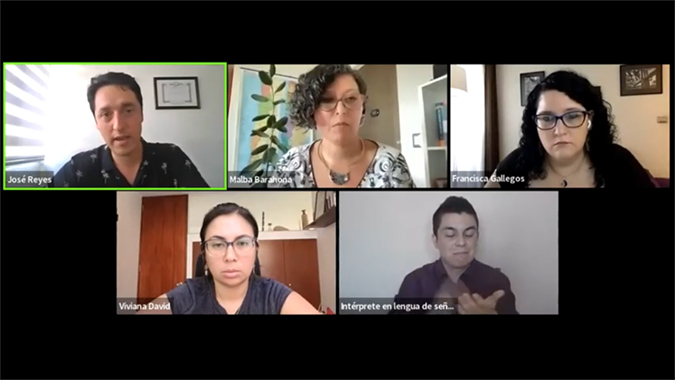The difficult task of teaching inclusively during the pandemic
January 13, 2022

That was what the webinar was about, led by three professors from the UC School of Education and a PhD student in Education, who presented the results of a FID project focused on the subject.
From the start of the health emergency due to COVID in Chile, platforms such as Zoom became one of the main spaces for interaction between teachers and their students. Although these technologies opened up opportunities to discover new tools to integrate into the classroom, they also presented different challenges for the entire school community and, in particular, for practicing teachers. To discuss these issues, on January 5, the seminar was held - via Zoom “How do you learn to teach English inclusively during the pandemic? Perceptions and experiences of English teachers in training”, led by the academic of the Faculty of Education, Malba Barahona.
The objective of the event was to present the results of a study within the framework of the Initial Teacher Training (FID) for the Faculty of Education from the Pontifical Catholic University of Chile. On the same, the Director of Undergraduate of the Faculty, Magdalena Muller pointed out that "it is framed in the objective of finding very concrete proposals for incorporate the variable of inclusive teaching in training programs. We highly value the adaptability of the team, since this project was designed when we were in a face-to-face context and they made an adjustment so that it could be applied within the opportunities that our students were having, remote teaching to carry out their internships”.
The study investigated how a group of six teachers in training faced the challenge of teaching English integrating the principles of Universal Design for Learning (UDAL)), which focuses on the importance of inclusion and accessibility, during a remote teaching practice. For Barahona, “Inclusion in the classroom is a challenge in teacher training in general, especially in virtual contexts, but for English teachers it is even greater. We are due and various studies mention that graduates are not prepared to face diversity and that pedagogical practices in classrooms do not include all students ".
The research team led by the academic, along with the UC Education teachers, Viviana David and Francisca Gallegos, and the student PhD in Education UC, Jose Reyes, reviewed different artifacts used in the classes of future teachers, such as PowerPoint presentations, exercise guides, and lesson plans, in order to analyze the presence or absence of UDL principles.
Regarding the presence of the first principle of universal design, focused on 'Promote multiple means of representation', "the most common was the use of gestures, especially in planning, and something that is repeated a lot are drawings, photos and the use of examples”, explained Viviana David. However, according to the teacher, the principle of 'Promoting multiple forms of motivation' was almost completely absent in all the resources.
According to Francisca Gallegos, "teachers are aware that there are specific strategies that they should include in their English classes to make them more inclusive, but when we review the artifacts we see that there are difficulties in implementing these strategies in their teaching practice”.
How to approach this challenge? For Malba Barahona learning to teach English in an inclusive way is a complex but possible process, and requires addressing various learning opportunities: “We must take charge of didactics and practices from a gender perspective and above all those that promote social justice, and to it's, the educators are called to focus, search and deploy pedagogical practices associated with inclusion”.
“It is important to see diversity as an opportunity and, therefore, the role of the teacher is to eliminate – or minimize – the barriers that may limit the learning and participation of the students”, Agregó.
Relive the webinar:
